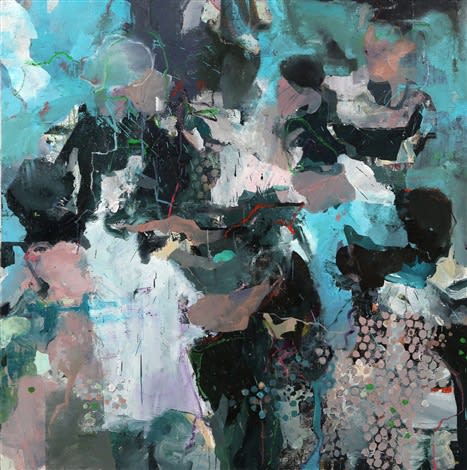'Perhaps it is only in the crowd that people cast off their petty day to day concerns and become subjects of history.’
George Lefebvre, a historian of the French Revolution
In this new body of work, Cian McLoughlin explores the theme of crowd behaviour, the powerful phenomenon that has persisted through history and across cultures, as a scaffold for making sense of the world, for saying what counts and understanding our relationship to others. In this series, the crowd becomes a metaphor for loss of self, a feeling of belonging and an arena for the expression of our strongest emotions.
The artist is less interested in the reasons for a crowd’s assembly or the aftermath of its activity, but rather the moment of oneness where, in the life cycle of the crowd, it has become the purest version of itself. Physical contact, pressure, compression and anonymity come together in the group to create an emergent sense of commonality which, at its most intense, challenges the boundaries of selfhood.
These works are dynamic and suggestive, hovering on the edge of abstraction. The activity they engage in and its motive remain ambiguous. As it is for a participant, the crowds in this series are confusing and disorienting at times, clear and precise at others.
The work draws on research on older, accepted theories of crowd behaviour and also the work of more contemporary social scientists such as Prof Stephen Reicher, who seek to challenge the anti-collective pathologising view of group behaviour that has dominated the field since at least the French Revolution.
Visual influences range from sources as varied as Matisse’s cut outs to Mughal art to Appolonio Di Giovanni’s 15th Century wedding chest decorations.
The gallery is publishing a hardback catalogue to coincide the exhibition. The introductory text by Sean Rainbird, Director of the National Gallery of Ireland, can be read below.
‘Madness and a Cure for Madness’: An Introduction
Cian McLoughlin has had over a year of disruption, like most, as our lives have been interrupted by the pandemic. Many of us have of necessity turned inward in response. An initial prediction of bursting creativity, unfettered by small distractions, is not how the reality of the ensuing lockdown months has unfolded for many people. Indeed the longer it has endured, a certain flatness has attended the everyday, defined by restricted boundaries and the withdrawal of so much of the unremarked ease of living.
Before this sliced across our collective experience, the National Gallery of Ireland had noticed and noted Cian McLoughlin’s artistic preoccupations, principally through his participation in our annual portrait exhibitions. His paintings were a distinctive presence, denoting a firm statement about self and biography articulated through art. One submission was of a tender depiction of a father holding a child, later shown not at the Gallery but in his ‘Middle Watch’ exhibition (2014).
In 2014 and 2017 two of the artist’s ‘Tronies’ – old Dutch for ‘face’ – were included in exhibitions of the shortlisted works. The first appearance was a painting with a strikingly yellow, strongly backlit head. A glowing, domed crown and forehead gave way to facial features cast in shadow. A second submission, this time subtitled ‘Woman Leaning Forward’ clarified gender and an inclination of the body. Individual identification in either painting, though, was hindered by the swirl of brushstrokes and overlapping eddies and flows of vivid colour that veiled their features. Through their titles, too, these works could be seen as adhering to the long tradition of non-portrait character heads that originated in the sixteenth century art of northern Europe. One of a series of heads the artist has made over several years, this time a self-portrait, was acquired by the Gallery in 2019.
The highlighting of a single head, or ‘Tronie’, lies at the opposite end of the spectrum of paintings in the Cian McLoughlin’s current exhibition. Anonymity, however, links these two bodies of work. In the pandemic year of 2020 McLoughlin began producing a body of paintings around the theme of crowds. Several of them were included in a spontaneously organised exhibition at the Gallery in the late summer of 2020. ‘Lace, Paint, Hair’, showcased the recent works of three contemporary artists, each using one of those materials indicated in the show’s title. The fluidity of McLoughlin’s earlier ‘Tronie’ works was superseded by drier interlocking angular planes covering the entire surface of the canvas in these new works. The notion of subject against ground in his heads gave way to dense arrangements of colours, some patterned or striped, others single-coloured. In some of them, we can read contours of heads and upper bodies. These figures in the crowd are, we surmise, located in spaces or landscapes. In others, the juxtaposition of contrasting shapes in the paintings, closely packed and sometimes animated by gestures with the brush, are purely abstract. Density, not movement; adjacent, airless arrangements, without intervals or gaps, confine the new mix of elements within these crowded assemblages.
With their suggestion of proximity, they are what has been absent in most of our daily lives these past 15 months. Their stresses and strains, surfaces rubbing against one another, suggest something intractable, unyielding, like the jostling of the anonymous crowds that we now miss in our encounters with fellow humans.
Sean Rainbird, Director of the National Gallery of Ireland

